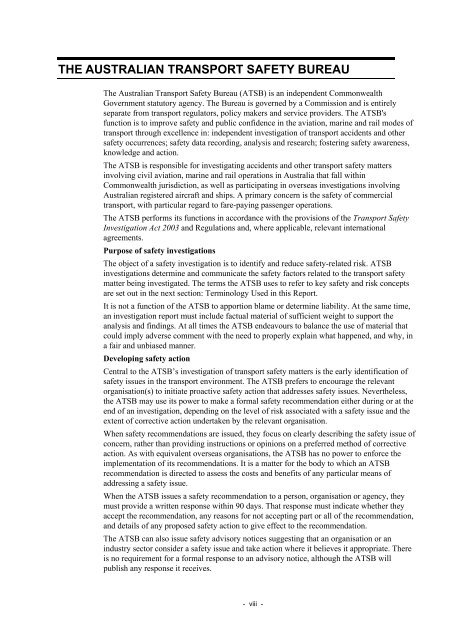Safety in the vicinity of non-towered aerodromes - Australian ...
Safety in the vicinity of non-towered aerodromes - Australian ...
Safety in the vicinity of non-towered aerodromes - Australian ...
You also want an ePaper? Increase the reach of your titles
YUMPU automatically turns print PDFs into web optimized ePapers that Google loves.
THE AUSTRALIAN TRANSPORT SAFETY BUREAU<br />
The <strong>Australian</strong> Transport <strong>Safety</strong> Bureau (ATSB) is an <strong>in</strong>dependent Commonwealth<br />
Government statutory agency. The Bureau is governed by a Commission and is entirely<br />
separate from transport regulators, policy makers and service providers. The ATSB's<br />
function is to improve safety and public confidence <strong>in</strong> <strong>the</strong> aviation, mar<strong>in</strong>e and rail modes <strong>of</strong><br />
transport through excellence <strong>in</strong>: <strong>in</strong>dependent <strong>in</strong>vestigation <strong>of</strong> transport accidents and o<strong>the</strong>r<br />
safety occurrences; safety data record<strong>in</strong>g, analysis and research; foster<strong>in</strong>g safety awareness,<br />
knowledge and action.<br />
The ATSB is responsible for <strong>in</strong>vestigat<strong>in</strong>g accidents and o<strong>the</strong>r transport safety matters<br />
<strong>in</strong>volv<strong>in</strong>g civil aviation, mar<strong>in</strong>e and rail operations <strong>in</strong> Australia that fall with<strong>in</strong><br />
Commonwealth jurisdiction, as well as participat<strong>in</strong>g <strong>in</strong> overseas <strong>in</strong>vestigations <strong>in</strong>volv<strong>in</strong>g<br />
<strong>Australian</strong> registered aircraft and ships. A primary concern is <strong>the</strong> safety <strong>of</strong> commercial<br />
transport, with particular regard to fare-pay<strong>in</strong>g passenger operations.<br />
The ATSB performs its functions <strong>in</strong> accordance with <strong>the</strong> provisions <strong>of</strong> <strong>the</strong> Transport <strong>Safety</strong><br />
Investigation Act 2003 and Regulations and, where applicable, relevant <strong>in</strong>ternational<br />
agreements.<br />
Purpose <strong>of</strong> safety <strong>in</strong>vestigations<br />
The object <strong>of</strong> a safety <strong>in</strong>vestigation is to identify and reduce safety-related risk. ATSB<br />
<strong>in</strong>vestigations determ<strong>in</strong>e and communicate <strong>the</strong> safety factors related to <strong>the</strong> transport safety<br />
matter be<strong>in</strong>g <strong>in</strong>vestigated. The terms <strong>the</strong> ATSB uses to refer to key safety and risk concepts<br />
are set out <strong>in</strong> <strong>the</strong> next section: Term<strong>in</strong>ology Used <strong>in</strong> this Report.<br />
It is not a function <strong>of</strong> <strong>the</strong> ATSB to apportion blame or determ<strong>in</strong>e liability. At <strong>the</strong> same time,<br />
an <strong>in</strong>vestigation report must <strong>in</strong>clude factual material <strong>of</strong> sufficient weight to support <strong>the</strong><br />
analysis and f<strong>in</strong>d<strong>in</strong>gs. At all times <strong>the</strong> ATSB endeavours to balance <strong>the</strong> use <strong>of</strong> material that<br />
could imply adverse comment with <strong>the</strong> need to properly expla<strong>in</strong> what happened, and why, <strong>in</strong><br />
a fair and unbiased manner.<br />
Develop<strong>in</strong>g safety action<br />
Central to <strong>the</strong> ATSB’s <strong>in</strong>vestigation <strong>of</strong> transport safety matters is <strong>the</strong> early identification <strong>of</strong><br />
safety issues <strong>in</strong> <strong>the</strong> transport environment. The ATSB prefers to encourage <strong>the</strong> relevant<br />
organisation(s) to <strong>in</strong>itiate proactive safety action that addresses safety issues. Never<strong>the</strong>less,<br />
<strong>the</strong> ATSB may use its power to make a formal safety recommendation ei<strong>the</strong>r dur<strong>in</strong>g or at <strong>the</strong><br />
end <strong>of</strong> an <strong>in</strong>vestigation, depend<strong>in</strong>g on <strong>the</strong> level <strong>of</strong> risk associated with a safety issue and <strong>the</strong><br />
extent <strong>of</strong> corrective action undertaken by <strong>the</strong> relevant organisation.<br />
When safety recommendations are issued, <strong>the</strong>y focus on clearly describ<strong>in</strong>g <strong>the</strong> safety issue <strong>of</strong><br />
concern, ra<strong>the</strong>r than provid<strong>in</strong>g <strong>in</strong>structions or op<strong>in</strong>ions on a preferred method <strong>of</strong> corrective<br />
action. As with equivalent overseas organisations, <strong>the</strong> ATSB has no power to enforce <strong>the</strong><br />
implementation <strong>of</strong> its recommendations. It is a matter for <strong>the</strong> body to which an ATSB<br />
recommendation is directed to assess <strong>the</strong> costs and benefits <strong>of</strong> any particular means <strong>of</strong><br />
address<strong>in</strong>g a safety issue.<br />
When <strong>the</strong> ATSB issues a safety recommendation to a person, organisation or agency, <strong>the</strong>y<br />
must provide a written response with<strong>in</strong> 90 days. That response must <strong>in</strong>dicate whe<strong>the</strong>r <strong>the</strong>y<br />
accept <strong>the</strong> recommendation, any reasons for not accept<strong>in</strong>g part or all <strong>of</strong> <strong>the</strong> recommendation,<br />
and details <strong>of</strong> any proposed safety action to give effect to <strong>the</strong> recommendation.<br />
The ATSB can also issue safety advisory notices suggest<strong>in</strong>g that an organisation or an<br />
<strong>in</strong>dustry sector consider a safety issue and take action where it believes it appropriate. There<br />
is no requirement for a formal response to an advisory notice, although <strong>the</strong> ATSB will<br />
publish any response it receives.<br />
- viii -
















